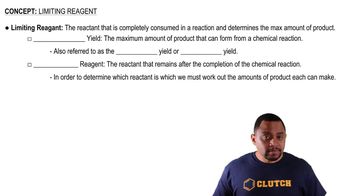Antacids are often used to relieve pain and promote healing in the treatment of mild ulcers. Write balanced net ionic equations for the reactions between the aqueous HCl in the stomach and each of the following substances used in various antacids: (a) Al(OH)3(s) (b) Mg(OH)2(s) (c) MgCO3(s) (d) NaAl(CO3)(OH)2(s) (e) CaCO3(s).
The commercial production of nitric acid involves the following chemical reactions:
4 NH3(g) + 5 O2(g) → 4 NO(g) + 6 H2O(g)
2 NO(g) + O2(g) → 2 NO2(g)
3 NO2(g) + H2O(l) → 2 HNO3(aq) + NO(g)
(c) How many grams of ammonia must you start with to make 1000.0 L of a 0.150 M aqueous solution of nitric acid? Assume all the reactions give 100% yield.
 Verified step by step guidance
Verified step by step guidance
Verified video answer for a similar problem:
Key Concepts
Stoichiometry

Molarity

Limiting Reactant

The commercial production of nitric acid involves the following chemical reactions:
4 NH3(g) + 5 O2(g) → 4 NO(g) + 6 H2O(g)
2 NO(g) + O2(g) → 2 NO2(g)
3 NO2(g) + H2O(l) → 2 HNO3(aq) + NO(g)
(a) Which of these reactions are redox reactions?
The commercial production of nitric acid involves the following chemical reactions:
4 NH3(g) + 5 O2(g) → 4 NO(g) + 6 H2O(g)
2 NO(g) + O2(g) → 2 NO2(g)
3 NO2(g) + H2O(l) → 2 HNO3(aq) + NO(g)
(b) Identify the element undergoing oxidation and the element undergoing reduction.
Consider the following reagents: zinc, copper, mercury (density 13.6 g/mL), silver nitrate solution, nitric acid solution. (a) Given a 500-mL Erlenmeyer flask and a balloon, can you combine two or more of the foregoing reagents to initiate a chemical reaction that will inflate the balloon? Write a balanced chemical equation to represent this process. What is the identity of the substance that inflates the balloon?
Bronze is a solid solution of Cu(s) and Sn(s); solutions of metals like this that are solids are called alloys. There is a range of compositions over which the solution is considered a bronze. Bronzes are stronger and harder than either copper or tin alone. (b) Based on part (a), calculate the concentration of the solute metal in the alloy in units of molarity, assuming a density of 7.9 g/cm3.
